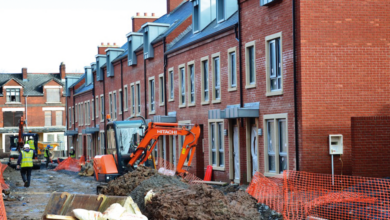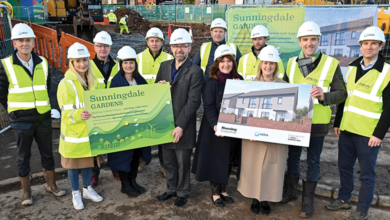Neighbourhood regeneration

The London School of Economics’ Bert Provan discusses neighbourhood regeneration and what actually matters to residents.
Discussing ambitions by the UK Government to use regeneration strategies to provide new and better homes across the country, as well as contributing to the growth of local economies, Provan points to schemes that are largely aimed at improving and increasing the provision of housing in poor areas, either through the redevelopment of existing estates, building new homes, bringing empty properties back into use or buying properties to rent out as social housing.
“The private rental sector now outstrips social renting in the UK. Research finds that many low-cost home ownership schemes are more likely to benefit better-off buyers and that many schemes are out of reach to most families on average earnings,” says Provan.
‘Right to Buy’ is by no means a way of enhancing social regeneration, according to the London School of Economics’ senior policy fellow. “In many cases this leads to those purchasing the properties selling on to private landlords. They, in turn, have no qualms as to who they lease the houses to. This leads to a downward spiral in terms of housing standards and the quality of the neighbourhoods that evolve.”
He highlights that the commitment by government to invest in public housing has fallen over the past number of years.
“In 1953 local councils across England committed to building 250,000 social houses. By 2004, this figure had dropped to 134,000. Admittedly, housing associations, had taken up some of this slack but the statistics, where house building is concerned, clearly shows that government has walked away from social housing.”
Provan reiterates that social housing estates are home to the UK’s most deprived people, adding: “Previously homeless people are more likely to live in these areas. They, in turn, present greater social challenges to both local councils and the other support services.
“The problems that present themselves include higher numbers of dependent children, higher pregnancy levels plus a greater predominance of both physical and mental disability incidences.
“Other poor-neighbourhood problems conclude a sense of isolation leading to depression, racial discrimination and stigma, abusive neighbours, crime, drugs, and poor policing plus concerns over the safety of children.”
Provan defines four different subtypes of neighbourhoods: transit, escalator, gentrifier and isolate.
Transit areas are deprived neighbourhoods in which most in-movers come from less deprived areas and most out-goers go to less deprived areas.
In escalator areas, most of the in-movers come from areas that are equally or more deprived, so that the neighbourhood becomes part of a continuous onward-and-upward progression through the housing and labour markets.
Gentrifier areas are areas in which there is a degree of social improvement since most in-movers come from less deprived areas and most out-movers go to similarly or more deprived areas.
Isolate areas represent neighbourhoods in which households come from and move to areas that are equally or more deprived. Hence, they can be seen as neighbourhoods that are associated with a degree of entrapment of poor households who are unable to break out of living in deprived areas.
Provan cites the physical upgrading of social housing developments as being a core response from government to the challenges faced by communities in many council estates, adding: “I welcome the £9 billion investment ear-marked for England in this regard, plus the £1.5 billion committed for similar development work in Northern Ireland.
Regeneration in the UK has a long and tortured history. Politics plays a major role in shaping policy, not research. There must be a recurring emphasis placed on both mixing and local engagement.
“But how can we tell if such an investment is generating a pay-off? According to the current UK National Strategy for Neighbourhood Renewal, no-one should be seriously disadvantaged by where they live.
“In France, the Cities’ policy aims to restore the value of neighbourhoods in difficulty and reduce the inequality between them and other areas through public sector actions while here in Northern Ireland Neighbourhood Renewal Partnerships have been key to creating local plans to improve everyday life for people in those areas.”
The academic further explains that government targets have been set to quantify the impact of social improvement. These included the attainment of five or more GCSEs at grades A* to C in every school and 38 per cent in every local authority area. There should also be a reduction, by at least 60 per cent of the conception rate among under-18s in the worst 20 per cent of wards.
Provan believes that the social return on the investment in regeneration can be assessed across seven different aspects of social value. These are: better housing; voice and control; jobs and the local economy; social and community development; crime and community safety; health and well-being; plus financial inclusion.
He adds: “Regular surveying of quality of life is crucial in tandem with resident inclusion on all development options that might be considered. The early development of a community plan is to be strongly advised as is the effective integration of new residents to encourage mixing.
“Regeneration in the UK has a long and tortured history. Politics plays a major role in shaping policy, not research. There must be a recurring emphasis placed on both mixing and local engagement.
“New techniques to formalise a social return on investment must be developed. There is a remarkable similarity across nations in how to approach regeneration, and of mixed results.”
Concluding, Provan says that effective social and community development can support the growth of strong community bonds within residents’ groups.
“Regular community engagement opportunities must be created. These must actively engage with hard-to-reach groups, including community facilities and grants,” he says.
“Mechanisms must be put in place for local residents and stakeholders to discuss the ongoing success of the development, such as resident governance structures or forums. Design features must be brought to bear, which bring a distinctive character to a social housing development and create local pride.
“Positive steps must also be taken which encourage social interaction from different tenures, as well as old and new residents. Successful neighbourhood regeneration can only occur when programmes and projects are firmly rooted in, and owned by, the local community. Interventions need to be integrated and long-term.”
Bert Provan is an Occasional Senior Research Fellow, and Knowledge Broker, in the Centre for Analysis of Social Exclusion at the London School of Economics.





